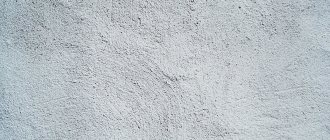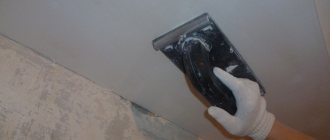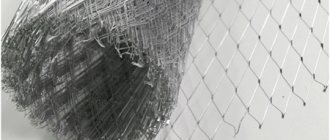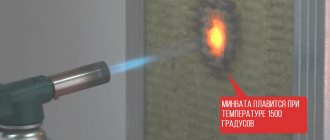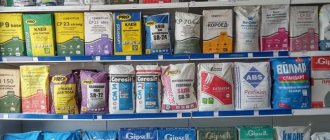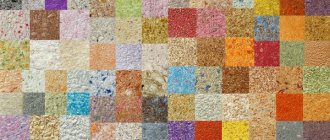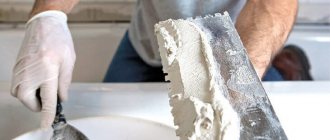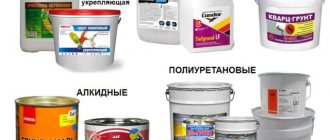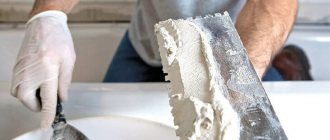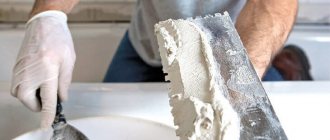Fiberglass mesh is a product included in the group of finishing materials that stand out from other finishing materials. Fiberglass mesh is a long-existing material that has acquired a number of qualities over time, which has generated considerable demand. The scale of production and sale of this finishing material has consequently increased.
What it is
I think everyone is familiar with ordinary glass.
This is a hard and rather fragile material, the main quality of which is transparency. However, if the same silicate or quartz glass is pulled into a thread, it will begin to demonstrate completely different properties. The glass thread bends easily without breaking. In addition, a bundle of glass threads has a fairly large surface with good adhesion (adhesion) to a variety of adhesive compositions. Facade fiberglass mesh is a woven material made from glass thread. Most often, the base is so-called aluminoborosilicate glass. The thickness of the thread and the mesh size determine the density of the fiberglass mesh and its area of application.
- Fiberglass meshes with a density of up to 90 grams per square meter are used for plastering internal surfaces and for painting work.
- Fiberglass meshes with a density of 90 to 220 grams per square meter are used for plastering facades using a variety of materials - concrete, aerated concrete blocks, shell rock and various insulation materials.
- Materials with higher density are used to reinforce parts of buildings located in the ground.
Of course, the mesh will not replace steel reinforcement. However, the outer layer of the foundation will be much stronger
Main types of mesh
To make the plaster applied to the outside of the building less susceptible to cracking and peeling, reinforcement is used.
Special reinforcing networks are:
- metal;
- fiberglass.
Metal facade mesh for plaster can, in turn, be divided into 4 types:
- woven;
- wicker or chain-link;
- welded;
- expanded metal.
You can visually compare the types of meshes using the photo below.
This will help evaluate their density and effectiveness in a particular application.
Types of metal plaster mesh.
- A woven net is made from a thin but strong and flexible material - steel wire - by weaving. A similar mesh with 1 cm cells, coated with zinc, is often used. In construction stores, such material can be purchased in rolls, convenient for transportation.
- The chain-link mesh, as a rule, has a cell diameter of 2 cm. When using this material, the plaster on the facade mesh is strengthened most firmly, since large cells make it easier to work when applying several wide layers of mortar.
- The welded type of mesh is made by spot welding at the intersections of wires and has square cells perpendicular to each other. In this case, galvanized wire coated with a special polymer composition serves as the main material. During active settlement of walls, such a mesh is the best protection against cracking.
Welded mesh for reinforcing bases.
- Expanded-extraction facade mesh for plaster is made by pressing metal sheets with cut holes. In this case, the cells are arranged in a checkerboard pattern. This material is available for sale in convenient rolls 1 meter wide. Used when it is necessary to apply a thin and neat layer of plaster.
Expanded mesh.
Using fiberglass mesh
Another type of facade material for wall treatment is facade plaster fiberglass mesh. This material is made from glass filament and is aluminoborosilicate glass.
In this case, the density of this matter is determined by the thickness and size of the threads.
Depending on this, the scope of application differs.
Fiberglass mesh for facade.
- With a density of up to 90 g/sq.m. The mesh is used during painting work or when finishing interior walls.
- If the mesh density is higher than 90, but less than 220 g/m2, then this material is more suitable for processing concrete walls, aerated concrete blocks, when installing insulation and when working with shell rock.
- Meshes with a higher density, the price of which is considered the highest, have found their use in the reinforcement of those parts of buildings that are located directly in the ground.
Fiberglass mesh and plaster reinforcing facade mesh are used to create a strong load-bearing base for the plaster. If it is necessary to apply a thick layer of plaster to an external wall, care should be taken to ensure the strength and durability of the structure.
On a flat wall, the solution quickly falls off and delaminates after drying. This is due to physics, since there is simply nothing for the plaster to grab onto. The use of meshes can significantly strengthen the structure.
Tips for novice repairmen
To decorate the exterior of the building yourself, you will need a few instructions that will help you avoid the most common mistakes and make high-quality repairs.
It’s worth finding out the advice of professionals to get the most durable and long-lasting coating.
- Installation is carried out in dry weather at temperatures above 5 degrees and air humidity less than 80%;
- The applied layers of plaster must be protected from direct sunlight in particularly hot weather, strong winds and heavy rain;
We plaster the facade using a grid.
- When using colored plaster, you should purchase materials from the same batch to avoid differences in color;
- Between the supporting structure and the thermal insulation there should be a distance greater than 45 cm from the thickness of the insulation;
Common mistakes that lead to defects when the plaster mesh for the facade does not help:
- Defect of uneven coloring (appears when layers of plaster of different thicknesses dry unevenly);
- Peeling of plaster in large pieces (occurs as a result of improper preparation of the walls or lack thereof, the same thing occurs when applying too thick a layer);
- The unevenness of the wall is visible (appears when applying too thin a layer of mortar);
- Peeling of plaster around the entire perimeter (often associated with the use of gypsum mortar, as it reacts with rain and promotes a more intense process of moisture absorption).
Scope of application of reinforcing mesh
Plaster mesh is widely used; its presence ensures high-quality covering of surfaces with different types of coatings. During construction and renovation, it performs the following tasks:
- strengthening the sheathing when thermal insulation and waterproofing are required;
- reinforcement of screeds, warm and self-leveling floors;
- facing joints with gypsum fiber sheets, panels made of plastic, wood, metal, polystyrene foam, and other blocks and slabs;
- increasing the adhesion of finishing fragments, as well as putty and plaster with bases made of foam plastic, sand-lime brick;
- giving optimal strength to the internal frame to avoid peeling, cracking and other integrity violations;
- increasing the resistance of surfaces to mechanical stress.
Fiberglass material can be used for internal and external cladding; it plays a particularly important role with large working surfaces, providing the opportunity for uniform drying and settling of putty and plaster, preventing the coating from cracking prematurely.
For external systems, strengthening facade coatings, and their decorative finishing, especially durable types of reinforcing material are used that can prevent destruction due to significant temperature changes, high humidity and other factors. In places of unevenness, seams and voids, the material acts as a frame, protecting the finish from partial destruction.
How to install facade fiberglass mesh
This type of mesh is much easier to install. The material is quite light, so it can be fixed by the facing material itself. However, in some situations, self-tapping screws are used for better fastening. First, the upper edge of the mesh is fixed, and then the entire remaining perimeter.
Healthy! When purchasing a mesh of this type, you should choose a material with cells no larger than 5 mm
It is also worth paying attention to the density, which should be in the range of 110-160 g/m2. In addition, for facing work it is required that the material be resistant to alkalis
Before starting work, just as in the first case, it is necessary to cut the material into sheets. Their size depends on how exactly the mesh will be positioned in the future (there is the option of laying along or across). If there are rusts on the surface, then it is better to distribute the material in one piece. If there are no serious defects, then the location can be any. But it is still recommended to cut the material with a small margin.
Healthy! When choosing fiberglass mesh, it is not necessary to buy a more expensive material that is resistant to UV radiation. This is just a marketing ploy. The fact is that any facing material itself must be resistant to sunlight. The mesh is located inside and has absolutely no need for such characteristics.
Despite the possibility of placing the grid in any convenient way, experts recommend:
- Unwind the rolled material and also fasten it parallel to the floor.
- Select one of the upper corners of the wall and start moving from it.
- Lay the material overlapping, regardless of whether metal mesh or a softer mesh is used.
- If possible, cut the canvas into large, solid pieces. This way you can achieve greater strength of the finished coating.
Fiberglass mesh laying technology
There are several methods for laying material. The first one is considered the simplest.
For this:
- Apply the first layer of plaster to the walls (you can also use putty).
- Apply the plaster mesh, lightly pressing it down.
- Apply a second layer of plaster material.
This way the mesh will be fixed with the solution. In this case, the operation can be performed in one approach. But it’s better to wait a little until the first layer sets.
Builders often take a more thorough approach. To do this, first a mesh is attached using staples, screws and dowels, and the plaster is also laid in two layers so that the reinforcing material is in the middle.
The procedure in this case is as follows:
- We mark the beacons and drill holes. We insert dowels into them.
- We install the screw heads, checking that they go exactly along the lines.
- Apply the first layer of plaster.
- We lay the mesh through the previously installed screw caps directly onto the wet plaster. We repeat the procedure with the adjacent section. Don't forget to overlap the mesh.
- We put on metal beacons and apply plaster on them.
There is also a special adhesive for fiberglass mesh on sale.
Installation of grids
Each type of reinforcement, taking into account the characteristics of the material. For more information about the types of construction meshes, watch this video:
Lightweight plaster mesh does not require special fixation.
Fiberglass mesh for plaster is secured around the perimeter with a mortar rubbed in with a spatula.
The strips are connected to each other with an overlap of 150-200 mm, for which, before starting work, the mesh is cut into strips taking into account this overlap.
Coating with polymer sheets
In some cases, plastic sheets are attached in the same way as. In other fastening options, they resort to the use of dowels and self-tapping screws. The material is attached with an overlap, placing one strip over the other by 150-200 mm.
Metal coatings
Metal plaster mesh can withstand fairly thick layers of finishing. Due to the fact that such reinforcement has a significant specific gravity, the fastening of metal reinforcement must be especially reliable. Installation of metal wall coverings is carried out as follows:
- The pre-reinforced coating is cut into fragments of the required size, not forgetting about overlaps when connecting the mesh overlapping.
- If the canvases have been stored in a warehouse for a long time, they are treated with a solvent or rust reducer.
- Thin coatings are cut with metal scissors. Welded and expanded metal sheets are cut with a grinder equipped with a metal cutting wheel.
- The mesh is fastened with dowels. To do this, holes are drilled in the wall (if the wall is concrete, then this is done with a hammer drill). Plastic dowels are inserted into the holes.
- Reinforcement begins from one of the upper corners of the wall. Having attached the mesh to the wall, screw the screws and washers into the dowels. The washers act as fasteners.
- A distinctive feature is that during such work the canvases are fixed in such a way that there is a small gap of 3-5 mm between the reinforcement and the wall. This is necessary to place reinforcement in the body of the plaster layer, which gives the wall decoration greater solidity and high load-bearing capacity. For a detailed description of the process, watch this video:
How to work with the material correctly?
Let's look at specific working methods.
Reinforced
When using a durable metal mesh, the work looks like this:
- The material is cut to size into the required fragments. Thin woven or chain-link fabrics are cut with metal scissors; welded or expanded metal are usually cut with a grinder with an appropriate disk.
- The base is being marked.
- Holes are drilled in the marked places on the wall, and dowels or wooden plugs are installed in them.
- Reinforcement of future plaster begins from one of the upper corners (the choice depends on the convenience of the master).
Mesh sheets are applied to the wall and fixed with self-tapping screws, using washers as clamps. In this case, the sheets are aligned with a plumb line; if necessary, spacers made of plastic or metal are used so that the wall is perfectly level. When strengthening the reinforced mesh, the plasterer must ensure that it does not fit tightly to the surface, but leaves a gap of 3 to 5 mm. This is necessary so that it is approximately in the middle of the plaster layer, ensuring maximum strength. - The mesh should be as even as possible and not sag. This is required so that voids do not form in the plaster layer.
- If necessary, beacons are attached to the base so that the rules move along them. This is necessary if the plaster mixture is applied in a thick layer. The beacons are fastened with gypsum mortar.
- The first layer is applied. It doesn't require much precision, so you just throw it on.
- After the first layer has set, apply the second. For this purpose, the plaster mixture is made more dense and dough-like. Application is carried out from bottom to top, with alignment as a rule.
- If necessary, apply a third layer. It is applied using the grout method, controlling the alignment of the slightest deviations from the vertical. The grout is applied using a trowel in a circular motion.
Fiberglass
Fastening the fiberglass material and applying plaster is carried out as follows:
- The roll is rolled out and cut to the size of the base fragment being processed. It is recommended to do this so that the mesh remains as integral as possible - fiberglass really does not like assembly from several parts.
- The surface is thoroughly cleaned. There should not be the slightest trace of previous plaster, wallpaper, paint or other coatings. The wall must be cleaned to a level base.
- Vertical beacons are installed at a distance of about two meters from each other. To ensure their evenness, you need to use a tensioned thread. Its tension is used to check the linearity of the fastening elements.
- If necessary, apply a primer. Typically the primer is applied in two layers. The first is given time to dry completely (from 2-3 hours to a day, depending on the composition), then the second is applied.
- A creamy first layer of plaster is laid on the wall. The reinforcing fragment is slightly sunk into the solution. Instead of the first layer, reliable glue can be used. The task is to attach the grid to the wall.
- A layer of plaster is applied in any way - with a brush, roller or otherwise.
- Along the beacons, using the rule, the layer of plaster is leveled.
Advice There is also a self-adhesive version of the plastic mesh on sale. To attach it to the wall, you just need to remove the protective layer, press it tightly - and after 3-5 minutes you can work. But this option is only suitable for surfaces that do not require leveling.
In other publications on the site, our experts also talk about the rules of plastering using foam plastic and penoplex.
How to install?
The installation technology depends on the material from which it is made.
To attach the metal mesh you will need self-tapping screws, dowels, metal scissors and galvanized mounting tape.
All work should be performed in accordance with the instructions:
- Using metal scissors, cut a piece of mesh to fit the wall and degrease it. To do this, you can use any solvent or acetone.
- Using metal scissors, cut the galvanized mounting tape into small pieces.
- The mesh must be installed from top to bottom, placing the canvas horizontally, starting from the ceiling itself. The upper edge of the first row is secured with self-tapping screws. Considering that the metal mesh has large enough cell sizes so that the mesh does not jump off the screws, pieces of mounting tape are placed under their caps so that it presses one side of the cell to the wall. There are widened nuts on sale that can also be used for these purposes, however, they are much more expensive than mounting tape.
- If the mesh is installed on a concrete or brick wall, then the fastening must be carried out using pre-installed dowels. To do this, you can use ordinary plastic parts, which are quite inexpensive.
- Fastening must be done often enough in a checkerboard pattern so that the mesh fits tightly to the wall. The ideal distance between dowels is 500 mm.
- The mesh panels are attached over the entire surface of the wall with an overlap of 80-100 mm.
- Fastening fiberglass plaster mesh.
This mesh does not need to be attached over the entire surface: it is enough to securely attach it along the upper edge. It is also attached starting from the ceiling. The cell sizes of such a mesh are small, and it itself is light in weight, which makes it possible to use only self-tapping screws, without additional devices such as mounting tape or nuts.
It is important that there is a piece of mesh left in the corners to create a slight overlap. The greatest strength can be achieved if the mesh is applied to the wall as a whole panel
Therefore, beacons must be placed using a grid already attached to the wall.
The greatest strength can be achieved if the mesh is applied to the wall as a whole panel. Therefore, beacons must be placed along a grid already attached to the wall.
Ceiling mesh reinforcement
Several materials can be used to reinforce ceilings.
Just like for walls, they use a mesh made of fiberglass, metal, as well as shingles - a structure made of wooden slats:
- It is recommended to use plastic or fiberglass mesh if the expected putty layer is no more than 30 mm.
- For height differences of more than 30 mm, it is better to use a metal mesh. It is much more expensive than plastic, but much stronger.
- Shingles have been used for many years. For its construction, a 20*8 mm rail is used, which is attached to each other in the form of slats. This is the simplest method of reinforcing a plaster layer, but is only suitable for wooden bases of simple construction.
Before attaching the mesh, it is necessary to prepare a mounting tape, pre-cut into small pieces with metal scissors. The metal mesh should first be degreased using acetone or other solvents. As a last resort, you can simply wash it with any soap and detergent that can wash away oil or grease traces.
The mesh needs to be cut to the size of the ceiling
It is important to remember that one canvas must overlap the previous one by at least 12-15 cm
Fastening:
- The shingles are attached very simply: you just need to nail the structure at the tops of the cells to the ceiling.
- Fastening a metal or plastic mesh can be done either with nails or with dowel-nails. They need to be arranged in a checkerboard pattern at a distance of 200-300 mm from each other.
- If you do not use a mounting grid, you can use nails with large heads or use washers.
The use of plaster mesh when sealing joints in floor slabs
To carry out these works, a strip is cut out of the mesh along the width of the area, adding 5-10 cm on each side. It is attached in the usual way and sealed with mortar.
In any case, the application of the solution should be started from the middle of the room, moving evenly towards the walls.
Application of chain-link mesh
Now chain-link is produced using carbon-containing, high-alloy steel wire. It comes with a polymer coating. The chain-link coated with polyvinyl chloride lasts longer. It is not subject to corrosive effects. Able to withstand actions from the outside. However, this mesh is often used to create fences and is produced in a different range of colors.
Chainlink is produced by weaving wire, which has a diameter of one to three millimeters in a spiral. Then they cross each other, forming a common mesh fabric. This metal mesh is suitable for covering walls in the construction of which adobe or clay was used, before applying solutions to their surface. Using the mesh, a reinforcing relief layer is created. It holds a large volume of plaster. The thicker it turns out, the larger the cells will be. Attach the mesh in the same way.
Taking into account the versatility of the use of reinforcing mesh, enterprises producing it have offered a huge variety of assortment of this material in construction. By understanding the main criteria when choosing, you can easily purchase roll material of excellent quality that is suitable for the job.
See below for quick and reliable fastening of the mesh to the wall.
Types of meshes
Today you can find quite a lot of options for fiberglass mesh on sale from a variety of manufacturers. Each type has its own specific characteristics and can be used for certain jobs. It is worth familiarizing yourself with the parameters and characteristics in advance in order to purchase exactly the fiberglass mesh that will allow you to carry out the necessary construction work.
Painting serpyanka
Painting serpyanka is a special fiberglass mesh for plaster, which has square cells. In most cases, you can find options in the form of a narrow stripe. Quite often, manufacturers additionally apply a special adhesive to one side. Painting serpyanka is most often used for reinforcing joints of different sheet materials, sealing damage and cracks, reinforcing putty at corners and completely leveling the surface of walls or ceilings.
Facade reinforced
In most cases, such material is used during the finishing of facades or at the stage of external insulation of a building.
It can also be used for interior work, but this option is much less common. When finishing the facade, using a reinforcing mesh, you can form a special internal skeleton for a layer of plaster. In the event that there are sudden changes in temperature or some kind of mechanical impact, fiberglass mesh will be able to provide the proper level of protection. Facade reinforced fiberglass mesh must be used during construction work to ensure a stronger finish and last as long as possible.
Universal
The universal fiberglass mesh has special characteristics and parameters, which allows it to be used for both internal and external work. It makes the finishing layer more durable, which has a positive effect on the condition of the building. At the same time, the surface of walls, ceilings or facades better withstand mechanical damage and sudden temperature changes.
What is reinforcing fiberglass mesh for plaster?
Reinforcing fiberglass mesh for plaster is a special building material that is used to improve the characteristics of finishing layers applied to the surface of walls.
Reinforcing fiberglass mesh for plaster is a special building material that is used to improve the characteristics of finishing layers applied to the surface of walls. This material is very popular because it has many advantages. The main ones include the following:
- High moisture resistance;
- The mesh does not begin to rot or rust over time, which will have a positive effect on the quality of the finish and its service life both inside and outside the house;
- It is relatively normal to withstand seasonal temperature changes;
- It is considered an environmentally friendly material;
- Has a high level of resistance to vibration loads and mechanical damage;
- At the same time, it has a fairly good elasticity indicator;
- This mesh has a very affordable cost, which is much lower than other types of reinforcing materials.
Due to this, it is possible to significantly increase the resistance of the material to alkaline environments, because such substances, as a rule, are contained in most of all modern plasters and putties. It is worth noting that fiberglass mesh can be used for a variety of construction purposes. The main ones include the following points.
- Allows you to strengthen the internal finishing layer so that the facing material adheres more securely to the wall. At the same time, in this way you can avoid the appearance of cracks and damage to the surface in the future.
- Using fiberglass mesh, you can increase the adhesion rate several times. This is a very important point, because not every surface will adhere well to plaster. In such situations, the use of reinforcing mesh is a must.
- Fiberglass mesh is often used to process seams and joints.
- Strengthen the joints of windows and doors with walls.
- It can be used to reinforce self-leveling floors, which makes them stronger and increases their service life several times, and also protects them from various types of damage and cracks.
It is very important to choose material only from trusted manufacturers, for which certificates are provided confirming the quality of the products. Otherwise, using low-quality fiberglass mesh will do more harm than good
Fiberglass mesh for plaster: from selection to fastening
Due to its characteristics, the plaster composition does not always lie perfectly on the surface. To secure it firmly, it is customary to use a special fiberglass mesh. Unlike its counterparts, fiberglass mesh has many advantages. Those who decide to use this material when carrying out finishing work should know how to choose and mount it correctly.
Fiberglass mesh is designed to reinforce the plaster layer and has increased resistance to alkali. In addition, it perfectly withstands high tensile loads and temperature changes. The use of fiberglass mesh significantly improves the quality of the plaster layer and extends the service life of the finished coating (examples of working with fiberglass mesh can be seen in the photo).
Characteristics
Today, fiberglass mesh has become quite popular in the building material market. This is due to its chemical neutrality and strength. This option also has excellent technical characteristics, which include:
- resistance to aggressive environments;
- excellent resistance to transverse and longitudinal loads;
- excellent adhesion to binders and mineral mixtures;
- the ability to improve the characteristics of the reinforced surface.
Selection of reinforcing material
When choosing fiberglass mesh, it is very important to first of all pay attention to the price. In this case, you should not choose the most inexpensive offers, since a quality item will not be cheap. In addition to price, it is important to choose the right manufacturer
Modern builders recommend giving preference to foreign manufacturers
In addition to price, it is important to choose the right manufacturer. Modern builders recommend giving preference to foreign manufacturers
It is important to determine in advance the required level of resistance to alkali, and for this you will need to first view the table, which indicates the standard values for this parameter. If the label of the fiberglass mesh contains values equal to the data in the table, then you can not be afraid and purchase this particular option
If the level of alkali resistance does not meet building codes, the fiberglass reinforcing material may dissolve in the plaster and leave behind voids. This situation will cause a lot of trouble in the future and will significantly shorten the service life of the wall covering (the photo shows a finished surface made using fiberglass mesh).
Installation of fiberglass mesh
Fastening the fiberglass mesh consists of several stages. Before you start work, you need to watch the video tutorial and take into account that the plaster layer should not be less than 3 mm and exceed 30 mm. Before installing the reinforcing material, the mesh is cut to the size of the canvas, which depends on how the reinforcement will be located - along or across the surface.
After the preparatory measures, a starting layer of finishing composition must be applied to the surface, on top of which a fiberglass mesh is laid. After this, the reinforcement is pressed into the starting layer, and finishing plaster is applied on top. In some cases, it is recommended to secure the mesh with dowels (along the edges of the canvas). This is necessary to prevent peeling of the finishing material.
- Before starting work, you should make a marking along which the mesh will be attached.
- The mesh is laid overlapping.
- The final layer of plaster is applied to the middle of the mesh and evenly distributed along the edges.
- The reinforcing fiberglass mesh should be laid on top of the freshly applied starting layer of plaster.
Performance properties
Fiberglass plaster mesh is made from thin threads, which are a product of glass melting. Thanks to a specific processing technique, the fabric is flexible, but at the same time elastic and with high strength values.
The characteristic properties of this material are:
- resistance to various, including aggressive, environments (this is facilitated by the presence of polyacrylic impregnation);
- good adhesion with various types of solutions and mixtures with a mineral base;
- resistance to various loads and mechanical influences;
- good tolerance to possible temperature changes;
- the ability to improve the performance of any type of coating and increase its service life.
Before purchasing fiberglass mesh reinforcement for plaster, you must ensure the quality of the material and its compliance with all necessary requirements. You can only be sure of this if you have a technical certificate.
Selection of working material
The main determining factor when selecting a material is its suitability for specific conditions, so the mesh for plastering walls is selected taking into account the following number of factors:
- the required thickness of the created finishing coating;
- the type of plaster mixture used;
- type of base (concrete, wood, brick, porous materials, stone);
- external conditions in which the formed plaster layer will be located: outside the building, inside, or in unheated, damp rooms.
Plaster using the following types of mixtures:
- cement-lime;
- gypsum;
- cement-sand;
- clay and others.
Various additives are often added to such compositions. They, together with the main components, have a certain level of chemical activity. Which determines the degree of their influence on the different materials from which the meshes for reinforcement are made.
Reinforced brick surface
Taking into account the above provisions, the main recommendations for choosing a mesh for plastering walls are as follows:
- It is recommended to use glass fabric products when the thickness of the created layer of plaster is up to 3 cm, when there are also depressions and cracks to stop the expansion of old ones and the formation of new ones;
- if the height of the coating being formed exceeds 3 cm, then a more appropriate option would be to install a metal mesh: it can withstand the weight of the finish without peeling off;
- It is better to use plastic products for gypsum mortars that are thin in thickness, and, for example, cement-sand compositions corrode such reinforcing material over time;
- when using clay-based mixtures, also when there are significant irregularities on the surface of the base, metal options are relevant;
- plastic sheets with small cell sizes (for example, 0.2-0.3 cm) are used during finishing putty work;
- fiberglass or galvanized (ordinary metal ones are not suitable) products are a good way to reinforce rooms with high humidity;
- when there is a need to plaster the stove with a cement-clay mortar, then you can use chain-link, and if it is a thin layer, fiberglass;
- steel products are suitable for joint use with compositions containing cement;
- When carrying out plastering work on finishing the external walls of a house, a material with cells of 3*3 cm is usually used, and larger sizes are selected to tighten the surface;
- For internal work, the material is mainly used in rolls, and for external work, in the form of sections.
Types of material
Mesh for walls under plaster has several varieties. To choose a material, it is recommended to familiarize yourself with the characteristics of each.
Polymer mesh
These are plastic mesh. This material is in high demand among finishers. The product is available in different cell sizes. Can be used even on uneven surfaces with large differences. The advantage of the product is its reasonable price.
Metal grid
This mesh is used primarily for exterior decoration. The material has increased strength and is used even for uneven walls with large differences.
Metal meshes are divided into several types:
- Woven mesh is a thin wire product that has increased resistance to mechanical damage and flexibility. It is used for reinforcing surfaces indoors and outdoors. Professionals advise using a mesh with a cell size of 1x1 cm.
- Woven mesh. Another name is chain-link mesh. Craftsmen use it to reinforce large-area building foundations. The dimensions of the cells are 2x2 cm.
- Welded - a mesh that is made from wire by welding. The rods are positioned perpendicular to each other and welded at the joints. The dimensions of the cells are 2x2 or 3x3 cm. The material is used if the object shrinks.
- Expanded metal is a mesh made of sheet metal. The material is made by rolling sheets on a special machine. The mesh can withstand the application of plaster in a thick layer. A distinctive feature of the mesh is that it increases the load-bearing capacity of the object.
Fiberglass mesh
Fiberglass mesh for plastering walls is a thin material with small or large cells. The first type is used for interior decoration. The mesh is fixed to the surface without large differences or defects. Usually the material is used for gypsum compositions. A fiberglass product with large cells is used for facades. Such materials can withstand increased loads.
PVC mesh
It is a thin fiber made of polyvinyl chloride. A distinctive feature is increased resistance to chemicals. How to plaster on PVC mesh is presented in video lessons.
Features of installing metal mesh
Plaster mesh made of steel is used much more often than a similar product made of fiberglass, since the metal version has the ability to retain its original shape not only during installation, but also during further use. In addition, it can be used provided that layers of plaster are applied, the thickness of which reaches 60 millimeters.
The fastening process begins with measuring the surface area. Then a piece of the mounting mesh of the required size is cut. A grinder or metal scissors will help with this.
Before installing the product, it must be degreased. For this purpose, a small piece of rag is dipped in a solvent, and then the metal is wiped with it.
The canvas is attached starting from the top. The connecting elements are self-tapping screws, used as gaskets, for which you can purchase:
- pieces of mounting tape;
- wide washers.
If the covering is made of concrete or brick, the material must be installed using plastic dowels, which are inserted into the wall holes.
When using self-tapping screws, remember that the distance between them should not exceed 500 millimeters. In this case, the spaces between the fasteners should not come into contact with the wall. Otherwise, the applied plaster will lose its original quality. The overlap at the joints is 80–100 millimeters.
The correctness of the work done can be determined by examining the tension of the mesh. The fixed canvas should not vibrate in places where there are no screws or dowels.
Technical characteristics of facade mesh
| Weight, g | 145 ±10 | 160 ± 10 | 125 ± 10 |
| Thickness, mm | 0,32 | 0,35 | 0,27 |
| Width, cm | 100 | ||
| Content of impregnating material, % by weight, not less | 17±3% | ||
| Breaking load, N/cm: - based | 1400 | 1800 | 980 |
| - one duck at a time | 1300 | 1400 | 720 |
| Breaking load after 28 days of exposure in 5% NaOH solution at t 18-30 C, N/cm not less than: - based on | 840 | 1080 | 500 |
| - one duck at a time | 780 | 840 | 360 |
Varieties
Fiberglass plaster mesh for façade reinforcing is produced in rolls 100 m long and 1 m wide. Thanks to these parameters, the material is convenient to use and transport.
The most important indicator that influences the area of application of the mesh is its density. Taking this criterion into account, the following types of material are distinguished:
- cells from 2 to 3 mm, density - from 50 to 60 g/cm3 - used in the process of work on internal surfaces;
- cells with a size of 5 mm, density - from 60 to 70 g/cm3 - most often used in the leveling process, on door and window openings, when waterproofing floors, as well as when puttingty and plaster;
- a cell size of 10 mm and a density of 100 to 120 g/cm3 indicate that the material is intended for reinforcement during the installation of insulated floors, concrete paths and their elements, steps of stairs and other structures that require increased load;
- cells 5 mm, density - from 120 to 130 g/cm3 - this version of the material is one of the most durable and is universal - it is used for reinforcing walls both inside and outside the building;
- cells from 5 to 10 mm, density - from 145 to 160 g/cm3 - used for puttying work and in the process of plastering building facades (for external insulation, restoration processes, foundation waterproofing);
- cells of 5 mm and a density from 270 to 340 g/cm3 are characteristic of armored material with enhanced strength. It is used when reinforcing the surface that will be finished with tiles, as well as in the process of strengthening the foundation of buildings.
A sign of high quality products is the presence of appropriate markings on them indicating the degree of strength and density, as well as the main purpose of the material. Symbols used for marking:
- N – the material is intended for outdoor work;
- B – intended to be used for interior work;
- Ш – denotes a mesh used for puttying;
- A – used for lower floors;
- U - speaks of increased strength.
Types and technical characteristics
In terms of its design, fiberglass mesh is a fabric that can be made of thin wire threads or a special polymer. Most often, fiber obtained from molten glass . Although glass is known to everyone as a very fragile material, in the form of a thin thread it begins to demonstrate amazing properties. Among them, first of all, extraordinary flexibility and elasticity should be highlighted.
This mesh exhibits amazing resistance to impact and bending, which makes it possible to create very strong threads from it.
The fiberglass mesh created from such threads is very light and durable and is perfect for reinforcing the mortar layer.
The stores offer several types of plaster mesh that can be used for finishing: painting, facade and universal.
Painting mesh
Its main purpose is to carry out finishing work indoors.
The material has a high density, which is about 60 g/m2. The cell dimensions are 25x25 mm.
This fiberglass mesh is used in the following areas:
- sealing chips, crevices and cracks on load-bearing surfaces;
- creation of self-leveling waterproofing;
- finishing of door jambs and window openings;
- putty and plastering of ceilings and walls inside buildings.
Facade material
It is mainly used for exterior decoration of building walls. Compared to painting mesh, fiberglass facade mesh has a higher density, which reaches 150-160 g/m2.
The façade mesh is also superior to painting mesh in terms of cell size, which is 50×50 mm.
This building material has the following scope of application:
- production of coating waterproofing for building foundations;
- puttying and plastering of facade surfaces;
- repair of walls and facades.
Universal purpose
This building material can be equally used not only for external, but also for internal work. The density of this mesh is 140 g/m2, and the cell sizes can have several different values.
For example, for a fine-mesh one their size is 6×6 mm, for a medium-mesh one – 15×15 mm, and for a large-mesh one – 25×25 mm. This plastering mesh can be used for all of the above work, from pouring the floor screed to plastering the façade.
In accordance with current building codes, the thicker the layer of mortar applied, the larger the mesh cells should be. For example, for a layer with a thickness of less than 20 mm, a mesh with a cell size of 6x6 mm will be sufficient, and for a layer of plaster of 50 mm, a glass mesh with a cell cross-section of 35 mm will be required.
Installation features
Any construction work involves preparatory actions and installation itself. The issue of the necessary tools is also considered.
Preparing the base
Since you will have to work with rolled materials, you need to provide free space, which will help avoid damage to the canvases and cutting into small pieces, which are often attached overlapping. For cutting, use a construction knife with replaceable blades or metal scissors. You will need to drill holes for the dowels, so you need a hammer drill and replacement bits.
The base is prepared in several steps:
- dismantle decorative trim;
- remove weak areas;
- open cracks;
- destroy biological damage and rust, oil stains;
- carry out preventive treatment of the facade with antiseptic and anti-corrosion agents as necessary.
If there are cracks, they are separately primed, filled with mortar and strengthened. Reinforcing elements are placed along the entire damage with a margin around the perimeter. Finally, the entire surface is impregnated with adhesive primer for exterior use.
To enhance the effect, you can deepen metal pins with threads (rod, self-tapping screw without a head) into the prepared grooves or secure pieces of perforated mounting tape with hardware.
Fastening the plaster mesh
Installation of facade mesh for plaster is carried out in different ways. The choice depends on the material used, the presence or absence of insulation. There are three options to resolve the issue:
- Dowel nail. Hardware is used to fix heavy metal sheets. The recommended number of fasteners, subject to a step of 25-30 cm, is 16 pieces per square. As an alternative, metal strips are attached on a relatively flat plane over the mesh in increments of 50-70 cm along the canvas.
- “Parachutes.” These are plastic dowels with wide caps. They are used for fixing slab and roll insulation. In order not to use long self-tapping screws with dowels, it is more convenient to fix the reinforcement using the same “parachutes” with light recessing of the threads into the body of the insulation.
- Solution. Lightweight fiberglass or mineral sheets can be secured to the base with glue or plaster. There is no need to immediately form a layer here. The coating will additionally act as a primer adhesion layer.
It is easier to attach lightweight canvases to wooden walls using construction staples using a stapler. The metal mesh is screwed or nailed with hardware with a wide head. Additionally, some craftsmen use galvanized mounting tape with holes. It is used to make loops that wrap around the mesh threads.
Installation technology
Installation of fiberglass mesh for plastering walls should not be done alone - this often leads to poor tension and is fraught with possible sagging of the material and the presence of air bubbles.
Sequence of work when plastering with fiberglass:
- Complete cleaning of the working surface from dust, dirt and debris.
- A base primer that disinfects it and increases adhesion to layers of putty and plaster.
- Preliminary plaster coating (it should be no more than 2/3 of the expected layer thickness).
- Dense laying of the reinforcing fabric on the mortar (pressing).
- Applying a special adhesive mixture using a spatula or roller. At this stage, all irregularities, folds and leaking solution are removed. The edges of the mesh should overlap each other by at least 10 cm.
- Applying the subsequent finishing layer (the reinforcement should not protrude through the coating).
During the installation of fiberglass mesh, nails, staples, and screws must not be used for fastening. This causes rust spots to appear on the treated surface.
Ekibana of autumn fruits: a basket of cones or acorns
Master class on making a basket
Ready product
Basket from a box
In autumn, there is literally a lot of decorative material lying under your feet that can be used to create an original autumn outfit. For example, you can collect acorns or cones and make an original basket out of them, which can later be filled with dried flowers, fruits or autumn leaves. The easiest way to make such a basket is to take an ordinary small cardboard box and carefully cover it with pine cones or acorns of the same size.
You can use a piece of grapevine as a handle for this craft. As a rule, it takes a little over an hour to make all the parts of an ekibana, and after that they are simply connected to each other with wire. If you are willing to tinker a little, you can make a basket exclusively from autumn fruits.
So:
- To begin, collect cones or acorns of the same size and shape.
- If you wish, you can bleach some parts using commercial bleach.
- Next, start forming the bottom of the future craft.
- To do this, take 6 cones and combine them into a flower (if the basket is larger, then you will need 12 or even 18 cones)
- If you use acorns, you can connect them together at the butts and then twist them into a tight spiral
- When the bottom of the basket is ready, begin to shape its depth.
- First, connect two or three cones together, and then form them into the wall of your basket
- At the next stage, using wire we connect all the workpieces together
- Add a grapevine handle to the basket and fill it with autumn apples, pears and rose hips
Features of fiberglass mesh
Fiberglass material has a number of positive qualities.
The main advantages should be considered:
- mechanical strength of the product;
- flexibility and elasticity in use;
- light weight material;
- reflection of corrosion and decay;
- increasing the adhesion of the plaster layer to the surface;
- resistance to deformation and any changes;
- compliance with fire safety standards;
- reinforcement of waterproofing and thermal insulation systems;
- resistance to temperature fluctuations and environmental changes;
- ease of fixation (attached to the mortar and adhesion of the plaster layer occurs);
- high resistance to tearing and damage.
With all the positive aspects, it also has negative sides.
The disadvantages of fiberglass mesh are:
- a layer of plaster of more than six or eight millimeters cannot be applied on top of the material;
- if used incorrectly, the perfect result will not be achieved;
- the occurrence of unpleasant sensations when interacting without protection.
Advantages of the material
The material is resistant to aggressive liquids
This material has a whole range of excellent performance properties.
The technical characteristics of fiberglass mesh are also improved by special heat treatment of the threads and coating them with polyacrylic dispersion compositions, which make it resistant to external aggressive influences.
Here is a list of the positive qualities of fiberglass mesh:
- Excellent mechanical strength. The mesh can withstand significant tensile and tensile loads, which makes it an excellent reinforcing material.
- Resistance to deforming loads. When bent or twisted, the mesh does not break or crack and easily restores its shape.
- Neutrality to aggressive chemical environments, both acidic and alkaline.
- Insensitive to changes in air temperature. Thanks to this quality, fiberglass mesh can also be used to decorate the street walls of buildings.
- Excellent elasticity makes it possible to cover not only flat surfaces with mesh, but also structures of rather complex shapes.
- The low weight of fiberglass fabric makes it easy to transport and store, and also makes it easy to install the mesh on load-bearing surfaces.
- The cellular structure of the mesh makes it possible for finishing solutions to adhere firmly to the wall, significantly increasing the adhesion of materials.
- Fire safety. The non-flammability of fiberglass makes it possible to use fiberglass mesh for finishing chimneys, fireplaces, heating stoves, etc.
- Easy to install. You can attach the plaster mesh in a variety of ways - from dowels and self-tapping screws to simply gluing it to the wall surface to be treated.
- Resistance to dampness makes fiberglass impervious to the processes of corrosion and rotting under the influence of dampness and other harmful influences.
The table shows the technical characteristics of fiberglass in comparison with other finishing materials created on the basis of glass.
Advantages and disadvantages
Among the many advantages of the material, the following should be mentioned first:
- light weight, due to which the mesh is often used when performing work on the ceiling;
- flexibility, making it possible to use it on uneven surfaces;
- immunity to corrosion, so even after a long period of time the coating will not rust.
However, fiberglass plaster mesh also has some disadvantages that should be taken into account when performing construction work:
- requires caution during use, as it contains microscopic elements of glass dust that can cause an allergic reaction;
- it is difficult for one person to work with the mesh - this can cause poor tension of the canvas;
- priming and puttying of walls, provided that a mesh is used, will require an increase in solution consumption;
- high cost of material.
However, these few disadvantages are more than compensated by the increase in service life, functional performance and practicality of different types of coating when using fiberglass mesh. This guarantees the absence of cracks, chips and shedding of plaster, which are a common problem when finishing buildings.
Kinds
In order to select the material necessary for the job, you need to have an idea of its characteristics. The main importance is the density, type of impregnation and the area for which a particular type of product is intended to work.
It is the size of the surface density that gives an idea of the strength and reliability of the mesh. There are three types:
- Plastering and painting products with a density from 50 to 160 g/sq.m. m. are used for interior work. Plaster ones have a higher density and larger cell size.
- When plastering facades and other exterior work, meshes of higher density are used - up to 220 g/sq. m. - with cell sizes from 5x5 mm to 10x10 mm.
- But when working with the basement floors of buildings and underground structures, the densest mesh should be used - up to 300 g/sq. m. Such materials can withstand severe loads, humidity, temperature changes and other adverse conditions.
To facilitate the selection of a material with a certain strength and properties, each product is marked. For example, the “SS” marking indicates that the mesh is glass; “H” and “B” warn that it should be used for exterior and interior use, respectively; the letter “A” denotes anti-vandal reinforcing products used in working with underground and basement structures, “U” – reinforced, etc.
It wouldn’t hurt to ask the seller and check the mesh’s compliance documents if you haven’t heard anything about the manufacturer or doubt its properties.
Types of plaster mesh
Reinforced mesh for plaster differs in the materials used for its production, the structure and size of the cells, and the methods of creation. According to the first criterion, the following varieties are distinguished:
- plastic;
- fiberglass;
- metal.
Products have all the advantages and disadvantages of the materials used to produce them.
A more detailed classification is presented in the table below.
| View | Cell size, mm | Characteristic |
| masonry (painting) | 5*5 | plastic sheet used when working outside and inside buildings using gypsum mixtures |
| universal: small, medium, large | 6*6, 14*15, 22*35 | the fine-mesh version is a suitable mesh for plastering internal walls, and the coarse-mesh version can withstand temperature changes and external loads well |
| fiberglass mesh | 5*5 | durable, resistant to moisture, cold and heat, chemical compounds |
| Plurima | 5*6 | made from polypropylene, chemically inert, used for external and internal work |
The nuances of installing a mesh with your own hands
The metal variety weighs the most and requires secure fixation with screws or nails. It is degreased (galvanized steel is simply washed with water or wiped with a rag) and cut with special scissors into pieces of the required size, taking into account the obligatory overlap of 10 cm into adjacent areas. In some cases, holes for dowels are prepared in advance, the step is 25-30 cm, on average by 1 m2 requires 16 fasteners. If possible, the edges are fixed with mounting tape (when working with large-mesh options, its use is mandatory).
It is better to finish metal-reinforced surfaces in two layers (not counting the spray), the second, thinner and leveling one is applied after the first has dried slightly. This type must be reliably covered with the mixture; it is important to choose the correct cross-section and method of connecting the wire; the thickness of the coating cannot be reduced below the recommended value. When working with fiberglass and polypropylene meshes for plaster, the solution itself or self-tapping screws can act as fastening materials.
In the first case, the canvas is placed in the middle of two layers; to increase density, it is better to unwind it directly on the spot, rather than cut it into separate pieces (the exception is the finishing of foam plastic, where segments are better suited). Plaster from the middle to the edges
When working with fiberglass and polypropylene meshes for plaster, the mortar itself or self-tapping screws can act as fastening materials. In the first case, the canvas is placed in the middle of two layers; to increase density, it is better to unwind it directly on the spot, rather than cut it into separate pieces (the exception is the finishing of foam plastic, where segments are better suited). Plaster in the direction from the middle to the edges.
But the more reliable and correct option is to fasten the dowels to a still dry wall, followed by spraying and applying the first layer as a base. The number of fasteners is minimal (one per canvas with a uniform step of 1-2 m), with a significant level difference they are used for installing beacons. The first layer of mortar is placed along the width of the product; after laying it, they proceed to the adjacent one, tracking the overlap of 10-15 cm with each other. Plastering for the purpose of leveling should also be done from the middle to the edge. Avoid sudden movements with a spatula, especially when working with facade mesh, otherwise they will come off along with the finishing composition. Correctness is checked visually - if they are visible under the leveling layer, then it is better to increase it by 1-2 mm.
Material cost
| Name, basis | Special properties, brief description | Cell size, mm | Roll size, m | Price per 1 m2, rubles | Price per roll, rubles |
| Plaster woven mesh made of galvanized wire | Wire diameter – 0.25 mm | 0,63×0,63 | 1×30 | 468 | 14040 |
| 1×1 | 208 | 6240 | |||
| The same - 0.4 | 2×2 | 162,50 | 4880 | ||
| 4×4 | 143 | 4290 | |||
| The same - 0.6 | 10×10 | 1×60 | 65 | 3900 | |
| 15×15 | 1×80 | 62 | 4990 | ||
| Non-galvanized chain-link | Wire diameter – 1.2 mm | 6×6 | 1×10 | 240 | 2400 |
| Welded galvanized | Wire diameter – 1 mm | 10×10 | 1×25 | 240 | 6000 |
| Fiberglass mesh | Serpyanka with a density of 45 g/m2, white | 2×2 | 1×50 | 18 | 900 |
| Plaster, impregnated with alkali-resistant polymer composition, 60 g/m2, white | 5×5 | 21 | 1050 | ||
| For facade, 160 g/m2, blue | 31 | 1550 | |||
| Plastic mesh Station wagon S | Colors: khaki, black. Used for finishing and rough layers up to 1 cm thick | 6×6 | 2×100 | 14 | 2800 |
| Syntflex E | High-strength, flexible, biaxially oriented polypropylene, for reinforcing layers up to 5 cm | 12×14 | 65 | 13000 | |
| C1-3, polypropylene | Gray color, for reinforcing plaster (up to 2 cm) and masonry | 13×13 | 1×30 | 21 | 630 |
